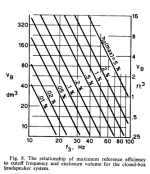Gents, I've been working with various sets of speakers for some time now, improving components, wire, adjusting things as I go. What you you say would be the primary contributors of gaining more bass out of any given set of speakers? For instance, does the amount of dampening material - less or more contribute? Value of capacitance / mH, longer tube, shorter, etc? Driver? If tackling a pair of speakers, where would you zone in first?
others know more than me but I'm guessing without changing the bass driver or type of loading that the cabinet volume is the biggest contributor
"jccart" is correct. Once the optimum, or desired, tuning frequency is determined for a specific driver in an enclosure, the bass response or reach will be entirely, or virtually so, dependent on the enclosure's volume if no other changes are made.
Paul
Paul
Thanks guys, so would it be safe to say that there is correlation between size of cabinet to level of bass response - and could that be extended to dampening material or removal of it, to increase volume and then therefore bass?
Right, attached are the sealed, vented box limits (net Vb) for a given tuning (Fc, Fb); eff. conversion.
To a limited amount, but the bottom line is we're always 'robbing Peter to pay Paul' (trading efficiency for BW).
To a limited amount, but the bottom line is we're always 'robbing Peter to pay Paul' (trading efficiency for BW).
Attachments
Power! Give it watts. Power with eq will give you bass, or a blown woofer. Actually, I burned up an amp putting 11Hz through it, so be careful! It was no great loss. Just a cheap Chinese amp for testing. Proof that electricity is made of smoke. That explains why it came out of the wires.
- Home
- Loudspeakers
- Multi-Way
- Contributors to BASS

